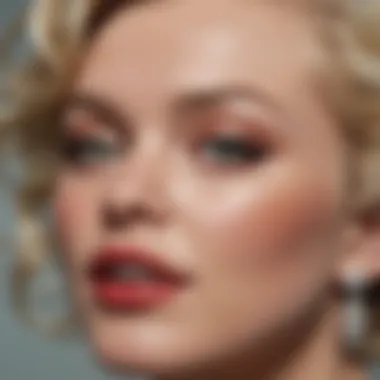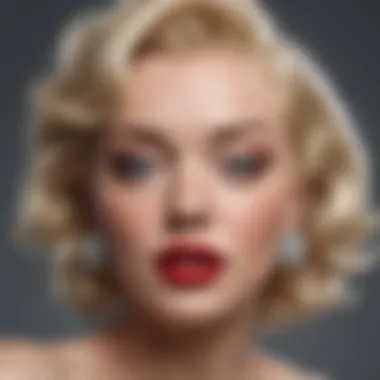Marilyn Monroe: The Evolution of Beauty and Surgery


Intro
Marilyn Monroe, an enduring icon of beauty and glamour, captures attention even decades after her passing. Her allure is often attributed to her unique combination of sex appeal and vulnerability, which resonated with many. However, the complexities of her aesthetic choices reveal a multifaceted relationship with plastic surgery, reflecting broader societal pressures and evolving beauty standards.
Rather than simply enhancing her features, Monroe's use of cosmetic enhancements signifies a profound interplay of personal agency and the cultural expectations of her time. This article explores this intricate relationship, providing insight into how Monroe's choices about her appearance contributed to her position as a cultural icon. The context surrounding her beauty pursuits reveals the evolving nature of beauty in a mid-twentieth century America, influenced by Hollywood, media, and public perception.
By examining Monroe’s aesthetic journey, we aim to uncover not only the personal decisions she made but also the societal trends that shaped these choices. The legacy of Monroe is intertwined with her understanding of beauty, femininity, and the role of fame—a narrative that continues to resonate today.
Prologue to Marilyn Monroe's Beauty
Marilyn Monroe personifies the essence of beauty standards during the mid-20th century. This introduction explores the foundational elements that characterized her appearance and the societal standards that she embodied. Monroe's beauty stirred conversations about female aesthetics, leading to a cultural dialogue that extended throughout the decades. Examining her allure offers insights not only into beauty norms of her era but also into how these norms have evolved over time. Her iconic status remains a topic of interest, revealing how personal choices intersect with societal expectations.
Cultural Impact and Icon Status
Monroe’s cultural impact is profound. She is often perceived as a symbol of femininity - a representation of both desire and vulnerability. Her glamour was not merely skin deep; it resonated with various social movements encouraging women to embrace their sexuality. This duality contributed to her icon status. Hollywood, in particular, propelled her image beyond cinema, embedding it into the cultural fabric of the time. Her influence on fashion and make-up trends cannot be overlooked, as they encouraged women to emulate her look.
Monroe's legacy persists in contemporary media. Her image continues to appear in films, advertisements, and various forms of art, signifying that her status as a beauty icon remains unchallenged.
Historical Context of Beauty Standards
Understanding the beauty standards during Monroe's time is critical. The 1950s marked significant shifts in societal expectations for women's appearances. After World War II, there was a strong societal push towards traditional femininity. In such an environment, Monroe represented an ideal. Her image reflected the desires and aspirations of many women, creating pressures to conform.
In this era, the emergence of mass media played a pivotal role in shaping beauty ideals. Print advertisements and cinema began to emphasize physical attributes, grainy stills of beauty icons were scrutinized, influencing perceptions of desirability. Moreover, the post-war economic boom allowed many women to access beauty products that became widely advertised. Thus, Monroe's beauty was not just personal; it was a product of the intricate dynamics of culture, economy, and media.
Monroe's story unfolds within a broader narrative of shifting beauty expectations. She embodies both the aspirations and contradictions of her time, providing a lens through which we can examine the evolution of beauty itself.
The Landscape of Cosmetic Surgery in the 1950s
The 1950s mark a significant era in the history of cosmetic surgery, intertwining social changes, medical advancements, and shifting perceptions of beauty. This period laid the groundwork for modern cosmetic practices and shaped societal expectations around appearance. Understanding this landscape is crucial to grasp the broader implications of Marilyn Monroe's relationship with beauty and surgery.
Emergence of Plastic Surgery
During the 1950s, plastic surgery began to transition from being a niche practice to a more widely accepted component of beauty culture. Following World War II, many surgeons had developed new techniques to repair war injuries, which inadvertently popularized the field. Surgeries like rhinoplasty and breast augmentation started to gain attention, not just for medical reasons but also for aesthetic transformations.
The public began to view these procedures as tools for achieving beauty ideals. Women, in particular, sought to enhance their appearance in line with the post-war feminine ideal. This surge in interest led to increased visibility for plastic surgeons and a burgeoning industry aimed at meeting these demands.
Influence of Hollywood
Hollywood played a pivotal role in shaping and promoting the aesthetics of this time. Film stars epitomized the beauty ideals of the 1950s, and cosmetic surgery appeared as a secret weapon in their arsenal. Marilyn Monroe emerged as a prominent figure in this landscape, her beauty captivating audiences and setting a standard for femininity.
As Monroe's fame grew, so too did the speculation around her appearance. Many believed she had undergone surgery to achieve her iconic look, which reflected the era’s shifting standards. The influence of Hollywood extended beyond stars like Monroe; it penetrated into the daily lives of women across the country. The images portrayed on screen created aspirational beauty goals, prompting women to adopt surgical enhancements in hopes of mirroring what they saw in their favorite actresses.
"In an era where Hollywood glamour dictated beauty norms, surgery became a pathway to reach an unattainable standard."
This dynamic interplay between cosmetic surgery and Hollywood not only redefined beauty but also led to societal acceptance of surgical procedures. The desire to attain a Hollywood-esque image became a driving force, and for many, it seemed essential to engage in cosmetic surgery in pursuit of that ideal.


As we examine Monroe's own enhancements, understanding this landscape provides context for her choices and the pressures she faced within a transformative socio-cultural framework. Her journey reflects broader trends in the evolving relationship between beauty, society, and the role of cosmetic surgery.
Monroe's Surgical Enhancements
Monroe's surgical enhancements are pivotal to understanding her beauty and cultural impact. Her choices in cosmetic surgery reflect broader societal trends while also revealing her personal struggles and desires. Monroe navigated an era where beauty was tied not only to talent but also to physical appearance, thus her surgical decisions contributed significantly to her iconic status.
Rhinoplasty and Its Effects
Rhinoplasty was among the first surgical procedures Monroe underwent. This operation aimed to reshape her nose, enhancing its appearance to align with popular standards of beauty during the 1950s. Many noted that it refined her facial symmetry and provided her with a more delicate aesthetic. Monroe's nose, post-surgery, contributed to her image as a timeless beauty, marking a shift towards more refined features in Hollywood.
In addition to cosmetic gain, rhinoplasty had a psychological impact on Monroe. It altered her self-image, offering her hope for a fresh identity as an actress. While such adjustments can appear superficial, they often stem from deep-rooted insecurities and societal pressures.
Breast Augmentation and Controversy
Breast augmentation further exemplifies Monroe's approach to beauty enhancements. Reports suggest that she underwent this surgery to achieve the voluptuous silhouette that became her signature look. This procedure was controversial, not least because it embodied the societal expectation for women to conform to certain body ideals.
The enhancements Monroe chose incited debate about authenticity in beauty. Critics argued that surgery betrayed a natural form while advocates highlighted self-empowerment through personal choice. She navigated these conversations publicly, showing how delicate the balance is between personal agency and external perception.
Facial Procedures and Public Perception
Various facial procedures accentuated Monroe’s allure and contributed to her legacy. These enhancements, including cheek augmentation and brow lifts, subtly shaped her visage, keeping her in the public eye as a peak of beauty. During the time, her evolving look became a subject of media speculation, instantly inviting public scrutiny.
Public perception played a significant role in how Monroe's enhancements were interpreted. Every alteration stirred discussions around beauty standards and expectations of women in society. Some valued her alterations as a means of empowerment, while others criticized her for chasing an unattainable ideal. These contrasting views illustrate the complex relationship women have with beauty, which persists in contemporary discourse.
"Monroe's beauty remains a living saga of societal expectations and personal choices, influencing generations to come."
In sum, Monroe’s surgical enhancements are not just aesthetic choices; they are deeply interwoven with her narrative, reflecting the evolving standards and the complex interplay between individual desires and societal demands.
Personal Agency in Beauty Decisions
Marilyn Monroe's journey through beauty decisions greatly reflects the notion of personal agency in a complex societal framework. Personal agency refers to the capacity of individuals to act independently and make choices that align with their values and desires. In Monroe's case, her decisions surrounding plastic surgery were influenced not only by her personal aspirations but also by external pressures from her relationships and the media. Understanding this intersection allows for a deeper exploration of her iconic status and how her choices contributed to evolving beauty standards.
Personal agency in beauty decisions encompasses several elements:
- Autonomy: Monroe aimed to shape her identity according to her own perceptions of beauty. Her choices in cosmetic enhancements are indicative of her desire to present herself in a way that she deemed aesthetically pleasing.
- Social Influence: The historical context highlights how social expectations impacted Monroe’s decisions. The allure of Hollywood glamour created a need to conform to specific beauty ideals. However, Monroe's ultimate choices were still rooted in her own sense of self, showcasing her personal agency.
- Empowerment: By actively choosing to undergo surgical procedures, Monroe exercised power over her appearance. This reflects a broader message about women's control over their bodies during a time when such autonomy was not widely accepted.
The narratives surrounding her choices allow for a nuanced discussion about beauty standards, self-perception, and the implications of cosmetic surgery. It is important to recognize the dual nature of personal agency—where individual choices are made, but they are often framed within societal expectations.
Influence of Personal Relationships
Monroe's relationships profoundly shaped her perceptions of beauty and her decisions regarding surgery. Her interactions with men, friends, and even family contributed to her evolving self-image. Notably, the admiration and criticism from those around her affected her confidence levels.
- Romantic Relationships: Monroe's connections with figures like Joe DiMaggio and Arthur Miller brought attention to her appearance. Their feedback could have reinforced her desire to align with the traditional standards of beauty celebrated in the media, leading her to make certain cosmetic choices.
- Friendships: The support or disapproval from close friends, particularly in Hollywood, influenced her self-esteem. Friends who possessed a keen understanding of beauty standards may have given Monroe a sense of validation or possible insecurity in her appearance, making her more inclined to undergo procedures.
- Mentorship and Guidance: Monroe received advice from industry veterans, which often emphasized the importance of physical appearance in securing roles and maintaining relevance. This external influence showcased how relationships could guide personal decisions, potentially steering her towards enhancements.
Through these dynamics, it becomes evident how Monroe's personal relationships intersected with her decisions about beauty and surgery, creating an intricate web of influence.
Monroe's Self-Perception and Confidence


Monroe's self-perception was a complex narrative influenced by her experiences, societal expectations, and personal decisions. Her confidence fluctuated throughout her life, shaped by the choices she made regarding her appearance.
- Impact of Plastic Surgery: Monroe's surgical enhancements aimed to boost her confidence. Whether it was rhinoplasty or breast augmentation, each procedure was linked to her quest for self-acceptance and assurance in a glamorous yet harsh industry.
- Struggle with Identity: Despite undergoing surgery, she grappled with her true self versus the image portrayed to the world. The disconnect between her public persona and personal feelings led to moments of doubt about her worth and beauty.
- Coping Mechanisms: To cope with the pressures of fame and self-identity, Monroe often sought validation through her looks. Each decision tied back to her self worth, where external affirmation played an integral role in shaping how she viewed herself.
Monroe and the Media's Role
Marilyn Monroe's beauty and allure were undeniably intertwined with the media landscape of her time. Her relationship with the press not only shaped her public persona but also influenced beauty standards in American culture. Monroe emerged as a symbol of femininity, captivating audiences with her charm, yet the very same media that elevated her status often scrutinized her choices and appearance. Examining this dynamic reveals how Monroe navigated the complexities of fame, celebrity culture, and personal identity within a society obsessed with looks.
Media Representation of Beauty
The representation of beauty in the media during Monroe's career played a crucial role in defining her image. Magazines, film studios, and advertisements perpetuated an ideal that was both aspirational and unattainable. Monroe became the epitome of the "blonde bombshell," drawing attention to her curves and glamor. Publications such as Life and Photoplay showcased her, solidifying her icon status.
Monroe's facial features, enhanced through surgical procedures, were often highlighted in these portrayals. Her nose job and breast augmentation contributed to a significant shift in the public's perception of beauty. The media celebrated her enhancements, aligning narrow standards of attractiveness with her own choices. By showcasing Monroe, the media perpetuated an image that many women aspired to replicate, compelling them to align with evolving beauty norms.
"Marilyn Monroe was not only a product of her time; she was a reflection of the societal ideals and pressures that surrounded her."
Public Scrutiny and Criticism
Despite her celebrated beauty, Monroe faced intense public scrutiny. Every aspect of her life, including her physical appearance, was under a magnifying glass. Media outlets often criticized her choices, implying that cosmetic surgery was a sign of insecurity. This resulted in a dual narrative: on one hand celebrating her beauty, while on the other hand dissecting it.
Monroe’s relationship with the media reveals the often contradictory nature of celebrity culture. Her fame placed her in a position where her worth was repeatedly tied to her looks. As a result, she dealt with an immense level of pressure to conform to the ideal beauty standards of the time. The gossip columns and critiques impacted her self-image and mental well-being, exposing the darker side of being a beauty icon.
In summary, Monroe's relationship with the media was multifaceted. While it gave her the platform to showcase her beauty, it also subjected her to relentless judgment. This dichotomy highlights the challenges faced by women in the limelight, underscoring the importance of understanding the media's influence on beauty standards in both the past and present.
Legacy of Monroe's Beauty and Surgery
Marilyn Monroe's complex relationship with her beauty and the role of plastic surgery has left a lasting impact on culture and aesthetics. Understanding this legacy is crucial for appreciating the social dynamics of beauty in contemporary society. Monroe is often viewed as a cornerstone in the evolution of beauty standards and surgical enhancements. Her life provides insights into how societal expectations can shape personal choices, especially in the realm of physical appearance.
The advancements in cosmetic procedures during Monroe's time were transformative. She often utilized surgery to enhance features that defined her beauty. By doing so, she paved the way for future generations to explore surgical options. This, combined with her iconic status, set a precedent that still influences perceptions of beauty today.
The importance of Monroe's legacy can be examined through several specific elements:
- The cultural reassessment of beauty standards spurred by her influence.
- The psychological implications associated with cosmetic alterations, particularly as they relate to self-esteem and societal pressures.
- Recognition of how fame can magnify the desire for physical perfection.
Monroe's legacy is also laden with benefits and considerations that continue to resonate:
- Empowerment vs. Conformity: Some view her choices as empowering, as they symbolize personal agency in defining one's appearance. Others argue they reflect conforming to rigid beauty norms, prompting ongoing debates surrounding self-image and authenticity.
- Cultural Impact: Monroe's impact extends beyond her life; it has initiated conversations about the nature of beauty and sexuality in a patriarchal society.
Her life illustrates the intricate dance between personal choice and social expectation, echoing through time and remaining relevant. The exploration of her legacy not only highlights Monroe's unique experience but also encourages the audience to critically evaluate current standards of beauty and the actions taken to achieve them.
Cultural Reassessment of Beauty Standards
The legacy of Marilyn Monroe necessitates a cultural reassessment of beauty standards. As society evolves, the image of Monroe has transformed from that of a mere sex symbol to a multifaceted icon representing various societal narratives.
In contemporary discussions, Monroe’s beauty is synthesized with issues of race, gender, and class, reflecting shifts in how society perceives ideal aesthetics. The ways in which Monroe navigated her beauty through surgical enhancements are often scrutinized, adding layers to our understanding of her influence. This reassessment demands that we reflect on:


- The Male Gaze: Monroe's beauty was often shaped by men’s desires. Understanding this dynamic can alter how we interpret her choices.
- Empowerment vs. Objectification: The duality of admiring Monroe's beauty while recognizing the objectification she faced invites a rethinking of notions of empowerment in beauty decisions.
This re-evaluation reveals the complex intersectionality of beauty in society and encourages deeper reflections on how cultural narratives surrounding appearance have developed over the decades.
Influence on Contemporary Beauty Practices
Monroe's influence is undeniably evident in contemporary beauty practices. Her choices concerning cosmetic surgery laid the groundwork for the beauty industry's growth, leading to widespread acceptance of aesthetic enhancements.
Modern beauty practices frequently draw from the elements that made Monroe an icon:
- Emphasis on Feminine Beauty: Many beauty trends still echo Monroe's iconic styles. From contouring to hairstyling, her look remains influential in beauty routines today.
- Rise of Cosmetic Surgery: Procedures such as rhinoplasty and breast augmentation have become commonplace. Monroe’s earlier decisions about her body set an informal standard for some.
- Media Influence: Just as Monroe navigated a media-driven world, today’s influencers often curate their own images through surgery and filters, perpetuating a cycle that began with her fame.
This connection between Monroe’s era and today's beauty standards raises important discussions about authenticity. As women of all ages engage with these practices, they must balance personal desires against external pressures. In understanding Monroe's legacy, there lies an invitation to question, adapt, and redefine what beauty truly means in an evolving society.
Psychological Aspects of Cosmetic Alterations
The psychological aspects of cosmetic alterations play a significant role in understanding Marilyn Monroe's relationship with beauty and surgery. In her era, beauty was not just a physical attribute; it was intertwined with identity, cultural expectations, and personal perception. The allure of Monroe’s beauty was both a blessing and a curse, influencing not only her career but also her mental well-being. As society looks to Monroe as an icon, it’s essential to evaluate how these enhancements affected her psyche.
Body Image and Mental Health
Marilyn Monroe's life illustrates the complex relationship between body image and mental health. Many individuals seeking cosmetic surgery aim to enhance their self-esteem and overall happiness. However, for Monroe, her surgeries may have stemmed from deeper insecurities. As she navigated her career, the public's perception of her physical beauty often dictated her value. Research shows that positive body image can significantly improve mental health, while negative impressions can lead to distress and dissatisfaction. Monroe’s journey is a reflection of this dichotomy, demonstrating how fluctuations in external validation can reshape one's internal sense of worth.
- Public Adoration vs. Personal Discontent
Monroe often relied on public praise to affirm her beauty and identity. The glamorous lifestyle brought attention but also immense pressure to maintain her image. This led to a cycle where aesthetic enhancements were seen as both a tool for success and a source of psychological burden. Her experience aligns with findings that emphasize how societal standards of beauty can lead to body dysmorphia, contributing to mental health issues.
Coping with Fame and Expectations
Fame often comes with a heavy price, as seen in Monroe's life. The expectations placed on public figures can be intense. Women in the spotlight regularly confront high standards regarding appearance, performance, and behavior. This phenomenon affected Monroe deeply. As her star ascended, so did the scrutiny. The desire to conform to an idealized beauty standard drove her to consider cosmetic alterations not merely for aesthetic purposes, but also to navigate the expectations that fame imposed upon her.
"Fame is like a mask that eats into the face."
— Mae West
This quote exemplifies the struggle celebrities face. Monroe's commitment to altering her appearance can be seen as a response to relentless societal judgment. For many, acknowledging the cost of fame is crucial in understanding how it fuels decisions around cosmetic surgery. Balancing personal desires with public image is a pivotal aspect of the conversation about beauty in the modern age.
Monroe's life embodies the intricate dynamics of beauty, identity, and mental health, opening a dialogue about how cosmetic changes influence self-perception in a world that often prioritizes superficial appearances. Understanding these psychological aspects can help frame discussions surrounding beauty—highlighting the necessity for personal agency and mental health awareness in the quest for self-improvement and societal acceptance.
Finale
The exploration of Marilyn Monroe's beauty through the lens of plastic surgery reveals not only her personal journey but also the complexities surrounding societal standards of beauty. This article highlights the importance of understanding how Monroe's choices were influenced by her environment and the pressures of fame.
Reflections on Beauty and Authenticity
Monroe's story serves as a reflection on the balance between beauty and authenticity. As she navigated the expectations placed upon her, it became clear that her enhancements were not just physical alterations but also a means of coping with her public persona.
- Beauty ideals in Monroe's era were stringent and heavily dictated by the entertainment industry.
- Her alterations allowed her to fit into these ideals while also grappling with her identity.
Monroe's journey underscores the broader debate about authenticity in beauty. The societal norms continue to evolve, yet they shape perceptions of self-worth today. This raises questions about how individuals define their beauty and authenticity in a world that often values appearance over substance.
Enduring Influence of Marilyn Monroe
Marilyn Monroe's impact on beauty standards persists. Her image continues to resonate well beyond her time. Today, many still look to her as a symbol of glamor and femininity.
- She has inspired countless artists, designers, and beauty influencers.
- Modern beauty practices still reflect aspects of her aesthetic, influencing everything from makeup trends to body ideals.
Understanding her legacy involves recognizing the duality of her influence: she both challenged and conformed to societal standards. As such, Monroe remains a pivotal figure in discussions about beauty, culture, and self-expression. Her life and choices offer a critical lens through which we can examine our own values regarding beauty in the contemporary world.



